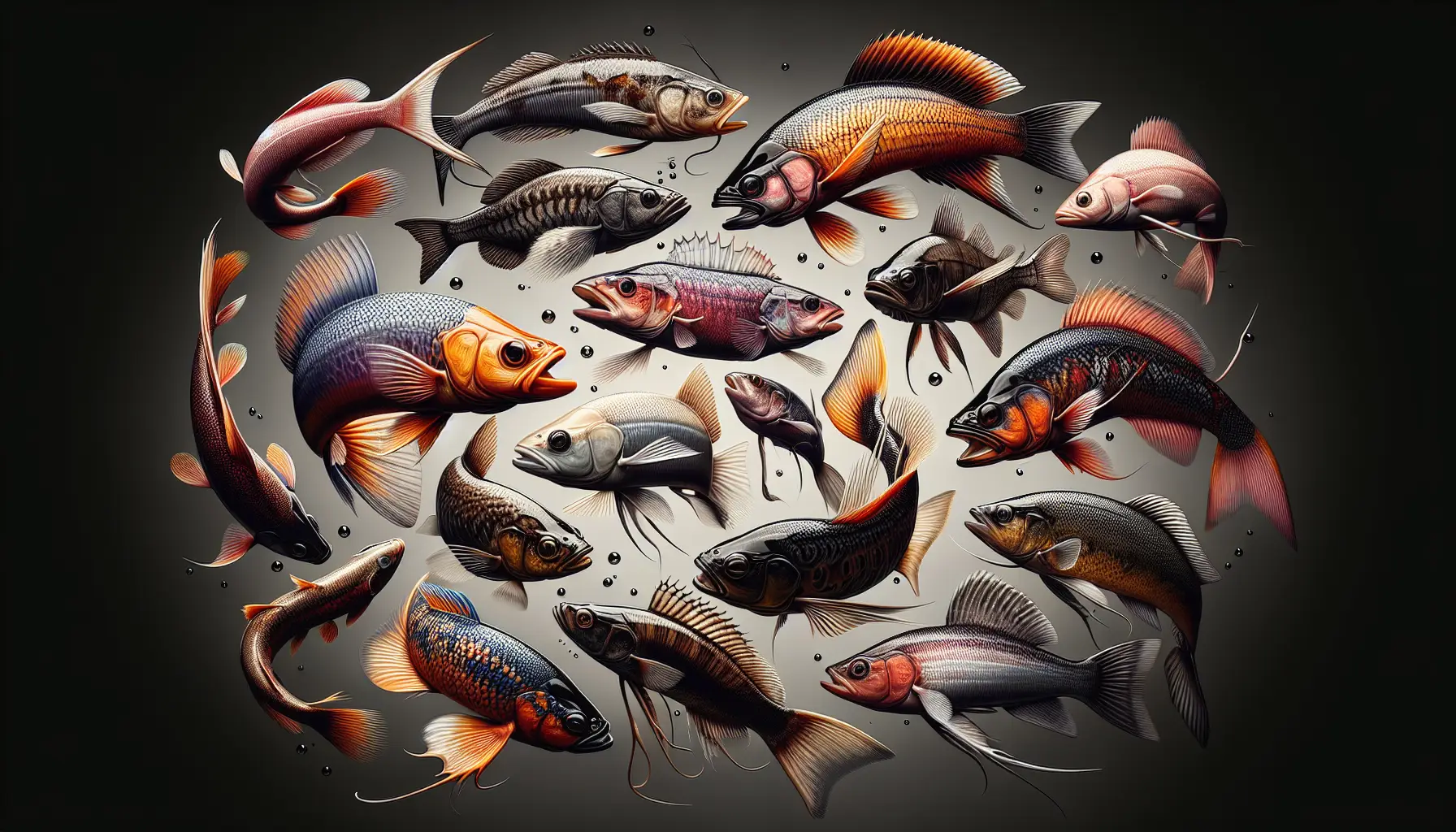Understanding Fish Behavior
Ready to level up your fly fishing game? It’s all about getting into the heads—or should we say, the scales—of fish. If you want to catch that prize trout, you’ve gotta understand what makes fish tick, especially how they “talk” without words.
Nonverbal Communication in Fish
Fish might not have tongues wagging, but they sure know how to get their point across. These slippery fellows have their own language through actions and appearances that speak louder than words. Think of their moves and colors as fishy emojis—expressive, if you know how to read them.
Here’s the scoop on their non-talking talk:
- Body Movements: Imagine fish showing off their dance moves. Each swish tells a tale, whether it’s happy, scared, or just showing off.
- Gestures: It’s like a silent film show. Fish use their fins and tails like hands, saying, “Hey, look at me!” or “Back off, buddy!”
- Posture: Want to know if a fish is stressed, in love, or picking a fight? Watch how it holds itself in the water.
- Color Changes: Some fish pull off color stunts that put chameleons to shame, letting their hues do the talking (HelpGuide).
Crack this code, and you’ll not just catch fish—you’ll outsmart them.
Visual Communication in Fish
Fish are all about the visuals, tuning into vibes through colors and motions. They’re like little watery artists, using their looks to send messages across the pond.
Here’s what they’re really saying:
- Movement: Flashy swim routines might mean, “I’m looking for love,” or “There’s a feast over here!”
- Posture: A fish’s pose can give away its social standing, claiming its turf or showing signs of good health.
- Coloration: Changing colors isn’t just flashy—it’s like mood rings. It signals everything from “I’m angry” to “I’m sick.”
- Patterns: Certain fish are fashionistas, flaunting stripes or dots to communicate—or just hide.
- Size Displays: Puffing up like a balloon might mean, “I’m the boss” or “Hey, come over for a date.”
| Visual Signal | What it Means |
|---|---|
| Movement | Wooing, warning, food alert |
| Posture | Status, territorial vibes, health signals |
| Coloration | Mood swings, health alerts |
| Patterns | Message broadcast, hide-and-seek |
| Size Displays | Power play, flirty invites |
Using their special eye sensors, these fishy friends pick up on the signals quick as a flash, making their watery world a true light show (Wikipedia). For the pro fly fisherman, reading these aquatic cues might just be your secret weapon.
Catch the fish by catching on to their ‘language,’ and fine-tune your fishing mojo to reel in the big ones. Get ready to become the whisperer of the waters, and may your lines be tight and your catches plenty.
Communication Methods
Fish got their own ways of gabbin’ and gabbin’—who knew? Whether they’re chirping through soundwaves or puffin’ up with pheromones, these slippery creatures have found inventive ways to chat it up underwater.
Sound Communication in Fish
When fish want to make a splash in conversation, they break out their arsenal of noises like grunts, croaks, and the curious boat-whistle, a sound that echoes like a mini orchestra using their swim bladders or pectoral fins as instruments. Take a grunt fish, for example, rumbling the underwater airways with its side fins. Catfish are the rockstars of the sea, croaking with authority using their air-filled bladders. And drum fish? Well, they’re the showboats hitting those high notes (shoutout to Wikipedia for the intel).
| Sound Type | Mechanism | Examples |
|---|---|---|
| Grunts | Pectoral Fin | Grunt Fish |
| Croaks | Swim Bladder | Catfish |
| Boat-whistles | Swim Bladder | Drum Fish |
Chemical Communication in Fish
Pheromones are like the underwater perfume, wafting through the water and giving fish a means to communicate without words. It’s an aquatic chat that extends beyond fish to critters like crabs and even some mammals. Salmon love rituals, taking to these chemical cues to organize spawning shindigs, while minnows spread alarm Netflix-style, warning each other of any aquatic drama. Thank your mechanoreceptors for this fishy gossip factory (Wikipedia).
| Chemical Type | Role | Examples |
|---|---|---|
| Pheromones | Reproduction | Salmon |
| Alarm Substances | Warning | Minnows |
| Territorial Markers | Dominance | Cichlids |
Electric Communication in Fish
Fish might not have electric guitars, but they’ve got skills. Enter electric fish, sending signals like Morse code through the water. The weakly electric fish, such as Glass Knifefish, flickers its way through darkness, while electric eels fire off powerful zaps to fend off threats. Elephantnose fish add some zing to their messaging with crisp electric pulses, keeping everyone in the loop with their instantaneous chat (Wikipedia).
| Electric Type | Purpose | Examples |
|---|---|---|
| Weak Electrical Signals | Navigation | Glass Knifefish |
| Strong Electrical Discharges | Defense | Electric Eel |
| Electric Pulses | Communication | Elephantnose Fish |
Tactile Communication in Fish
When it’s time for some personal interaction, fish aren’t shy about using a little physical touch. From soft nudges to ramming sessions, these aquatic tussles show who’s boss. Whether it’s Cichlids being all lovey-dovey with rubbing rituals or Betta fish butting heads to claim their turf, it’s all in a day’s work in the fish world. Percussive interactions are marked through enhanced communication between fish using body chit-chat (Wikipedia).
| Tactile Type | Behavior | Examples |
|---|---|---|
| Rubbing | Mating Rituals | Cichlids |
| Butting | Territorial Fights | Betta Fish |
| Ramming | Dominance Display | Surgeonfish |
Each fishy conversation style shapes their undersea life, letting them navigate the social whirlpool and keep things flowing in their watery ‘hood.
Interpreting Fish Body Language
Swimming Patterns
Fish can be real chatty without saying a word—all in the way they swim! If they’re zipping around like crazy, they might be feeling a bit edgy or scared. On the flip side, if they’re coasting along nice and slow, they’re likely just chilling and taking it easy.
| Mood/Behavior | Swimming Pattern |
|---|---|
| Stress/Fear | Rapid swimming |
| Comfort/Relaxation | Slow and calm swimming |
Color Change
Fish fashion is spot on when it comes to playing the dating game or dodging danger. When they’re in the mood for love, you’ll notice them flaunting some snazzy bright colors, hoping to catch a mate’s eye. On the other hand, if they suddenly blend into the decor, they’re pulling a James Bond to sneak past predators.
| Situation | Color Change |
|---|---|
| Courting/Mating | More vibrant colors |
| Avoiding Predators | Blending with environment |
Body Posture
A fish’s stance is like a health report card. If they’re hunched over or drifting sideways, something’s bugging them, either stress or the sniffles. But when they’re upright and nosy, poking around their tank, all seems to be healthy in their watery world.
| Mood/Health | Body Posture |
|---|---|
| Stress/Illness | Hunched-over or sideways |
| Healthy/Content | Upright and active |
Fin Positioning
Fins are like the jazz hands of fish expression. When those fins are clamped down tight, the fish’s saying, “Not cool, man!” Stress or fear might be lurking. However, if they spread out and glide through the water gracefully, that fish is probably as relaxed as a hammock.
| Mood/Behavior | Fin Positioning |
|---|---|
| Stress/Fear | Clamped fins |
| Relaxed/Comfortable | Extended and graceful fins |
Getting a read on these finned friends’ hints can help anyone from your neighborhood fishing enthusiast to seasoned pros understand their underwater body’s thoughts about life. Watching how they move, their color, stance, and where those fins end up can help in figuring out what they’re feeling and how to catch them on a good day!
Signs of Fish Emotions
Getting to know your fish’s feelings isn’t just about being a fish whisperer; it’s also about making sure they’re swimming in good vibes. Let’s dish out some pointers on how to read fish emotions for a happier tank and a rad fishing day.
Indicators of Happiness
Your fish might not wag tails, but they sure have their ways of showing they’re content. Spotting these happy signals keeps your fish friends lively and their habitat tip-top.
- Active Moves: Think Michael Phelps on a good day—darting around with joy.
- Chillin’ Breathing: Easy peasy breaths, no heaving or gasping.
- Food Enthusiasm: Rushing like it’s a sushi buffet.
- Fit Figure: Holding a shape that’s more Miss Fish Universe than jelly belly.
- Social Butterfly: Playing nice with other fish, maybe even showing off a little.
And some fish species? They’ve got their own quirks:
- Hue Boost: Flashy colors popping like they’re ready for a night out.
- Bubble Architexture: Betta dudes, I’m looking at you.
- Pranks Ahoy: Pulling off some nifty swim tricks.
- Tank Buddies: Becoming besties with their water neighbors.
| Indicator | Description |
|---|---|
| Active Moves | Zipping around the tank |
| Chillin’ Breathing | Smooth breathin’ vibes |
| Food Enthusiasm | Racing to grub time |
| Fit Figure | Lookin’ like a fitness champ |
| Social Butterfly | Proper social manners |
| Quirky Stuff | Color pop, bubbles, playful swim |
Reference: Hygger
Signs of Stress in Fish
Stressed fish? Yeah, that’s a thing, too. Catch these stress signals early, and you’ll keep your underwater buddies chillin’ in no time.
- Bored Fish Syndrome: They’re ghosting food and the tank scene.
- Weird Swim Styles: It ain’t synchronized swimming—it’s more like a confused freestyle.
- Color Fade: They’re less bling and more meh.
- Body Language: Fins pulled in tight, looking all cramped and awkward.
- Tank Trouble: Extra crabby with tank mates or turning on themselves.
For female cichlids, stress shows in their jurassic park moods and not caring much for their home turf.
| Stress Indicator | Description |
|---|---|
| Bored Fish Syndrome | Cold shoulder to chow and adventure |
| Weird Swim Styles | Wigged-out or sluggish moves |
| Color Fade | Dullness takes over |
| Body Language | Scrunched fins, awkward poses |
| Tank Trouble | Turning into mean fish or self-harm |
Reference: Hygger
Fixing Fish Stress
Got stressed fish? Show ‘em some love with a sweet setup and chilled-out care routine.
- Water Heaven: Good pH, homely oxygen levels, and less “yucky stuff” floating around.
- Room to Swim: No sardine life—plenty of space to stretch those fins.
- Friendly Roomies: Matchmake your fish like Tinder pros to avoid squabbles.
- Snack Schedule: Keep it steady, no feast or famine drama.
- Hands Off: Less handling, more hands-free love, alright?
| Action | Benefit |
|---|---|
| Water Heaven | Cribs in perfect condition |
| Room to Swim | Cuts down fish drama |
| Friendly Roomies | Stress-free waters |
| Snack Schedule | Bye-bye, feeding frenzy |
| Hands Off | Keepin’ it cool without humans |
Reference: Hygger
When you peel back the aqua curtain and get fish emotions, it’s not just about better fishing tales. It’s about making sure the fishy lives you keep are relaxed and sway to life’s tranquil groove.

